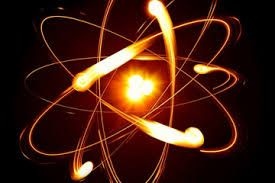
The electron is an elementary particle having a negative sign elementary charge and is one of the components of the atom with neutrons and protons. It is fundamental chemistry as it participates in almost all types of chemical reactions and is a key element of the bonds in the molecules. In physics, the electron is involved in a multitude of radiation and effects. Its properties, which appear at the microscopic level, explain the electrical conductivity, thermal conductivity, the Vavilov-Cherenkov, incandescence, electromagnetic induction, luminescence, magnetism, electromagnetic radiation, optical reflection and superconductivity, macroscopic phenomena widely exploited in industrialized countries. With the lowest mass of all charged particles, he regularly used to study the matter.
The concept of an indivisible amount of electric charge is developed from 1838 by the British naturalist Richard Laming to explain the chemical properties of atoms. The electron is identified as the particle envisaged by Joseph John Thomson and his team of British physicists in 1897, as a result of their work on cathode rays.
It was at this time that Thomson provides its atomic model. In 1905, Albert Einstein proposed an explanation of the photoelectric effect - the electrons emitted by matter under the influence of light - that will serve as an argument in favor of the quantum theory. In 1912, Niels Bohr explained the spectral lines by postulating the quantification of the orbit of the electrons from the hydrogen atom, another argument supporting this theory. In 1914, the experiments of Ernest Rutherford and others have firmly established the structure of the atom as a positively charged nucleus surrounded by electrons of lower mass. In 1923, the experimental results of Arthur Compton convince a majority of physicists of the validity of the quantum theory. In 1924, Wolfgang Pauli defines the Pauli exclusion principle, which means that electrons possess spin. The same year, Louis de Broglie hypothesized, verified later that electrons exhibit wave-particle duality. In 1928, Paul Dirac published his model of the electron which led him to predict the existence of the positron and antimatter. Other studies of the electron properties have led to more comprehensive theories of matter and radiation.



